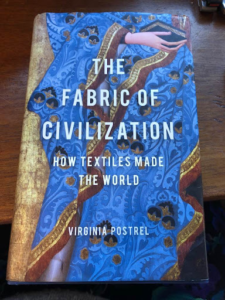Book Review
The Fabric of Civilization: How Textiles Made the World, by Virginia Postrel
Hatchette Book Group, New York, 2020
In just seven chapters, author Virginia Postrel analyzes and presents an amazing body of research on how textiles brought continuity and economy on a world scale. Once agriculture arrived on the scene, how did we move from a localized agrarian society to one of trade and banking across the world?
Postrel reveals that textiles funded the business scene during the Italian Renaissance and Mughal Empire. Dyes, woolens, and precious fabrics like silk promoted trade between Asia and Europe, as well as Africa, thus bolstering trade between the continents.
As the textile trade spread far and wide and values varied, a uniform standard was needed to keep track of values of cloth and finished textiles, giving rise to Bills of Exchange. These letters would inform a merchant’s “home office” bank of their dealings and direct the bank to honor a bill when presented, even if the merchant were not available. These were not official state-sanctioned documents but rather a correspondence between the merchant, their bank, and the customer, almost like today’s invoice.
These bills of exchange were easier to transport than silver or gold and began the practice of credit. In Venice, double-entry bookkeeping arose at the same time, primarily due to the textile trade. Thus perfected, many merchants desired uniformity and sent their staff to Venice to learn these new accounting skills.
Postrell brings us forward to contemporary times, smart textiles, and the ability to embed tiny lithium batteries and chips into garments. In the near future, we can slip our cell phone into our pocket and charge it using embedded, lithium batteries. Another forward-thinking project is using silk proteins to create a scaffold to support soft tissue during and after surgery.
Overall, an excellent read and highly recommended.
For next page click here
